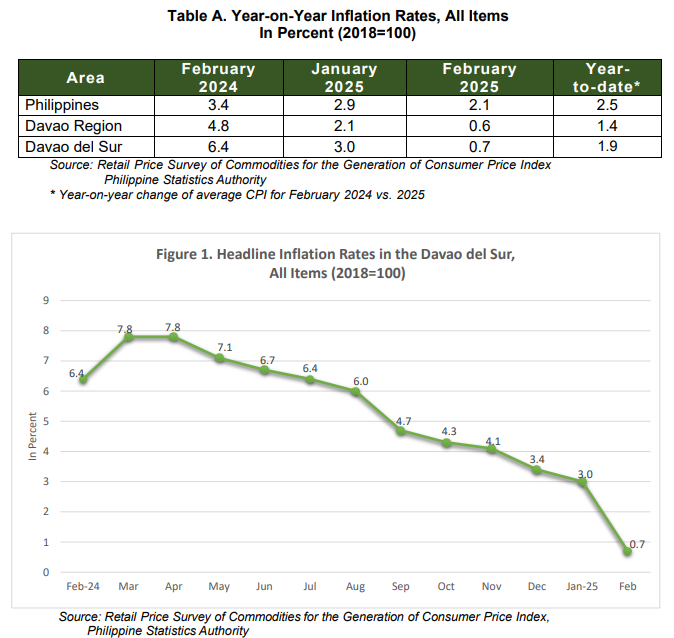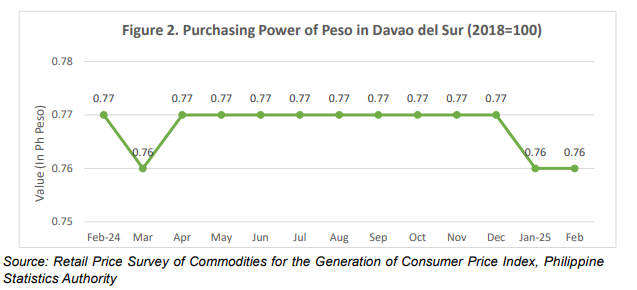
DAVAO DEL SUR
1. Headline Inflation
In February 2025, Davao del Sur's headline inflation dropped to 0.7 percent, marking a 2.3 percentage points decrease from the 3.0 percent inflation rate recorded in January 2025. The current inflation rate was 5.7 percentage points also lower compared to February 2024’s inflation rate (6.4 percent). Meanwhile, the province's average inflation rate was at 1.9 percent. (See Table A and Figure 1).
1.1. Main Drivers Contributing to the Movement of Headline Inflation
In February 2025, the decrease in headline inflation in Davao del Sur was mainly attributed to (a) Food and Non-Alcoholic beverages, which decreased to 2.1 percent from 5.3 percent in the previous month. The second largest contributor was (b) Housing, Water, Electricity, Gas and Other Fuels, which fell to 2.1 percent from 5.3 percent in January 2025. This was followed by (c) Restaurants and Accommodation Services at 1.7 percent inflation rate from 5.9 percent in the previous month.
In addition, decreasing trends were also observed in the following commodities:
a. Transport at negative 4.0 percent, from negative 1.1 percent in the previous month;
b. Furnishings, Household Equipment and Routine Household Maintenance, at 4.4 percent from 6.6 percent in the previous month;
c. Personal Care, and Miscellaneous Goods and Services at 4.2 percent from 5.6 percent in the previous month;
d. Health at 2.3 percent from 3.9 percent in the previous month;
e. Clothing and Footwear at 3.1 percent from 3.8 percent in the previous month;
f. Alcoholic Beverages and Tobacco at 7.4 percent from 7.8 percent in the previous month; and
g. Recreation, Sport and Culture at 4.0 percent from 4.7 percent in the previous month.
On the other hand, only one commodity group showed an increasing rate which was Information and Communication at 2.9 percent compared to 1.7 percent in January 2025.
Compared to the annual rates of the previous month, the following commodity groups maintained the same rate:
• Education Services, 4.9 percent; and
• Financial Services, 0.0 percent.

2. Food Inflation
Meanwhile, the province’s food inflation decreased to a negative 1.2 percent in February 2025 from 1.5 percent in the previous month. The decrease was mainly due to (a) Vegetables, tubers, plantains, cooking bananas and pulses at a negative 7.2 percent, from 8.8 percent in the previous month. This was followed by (b) Fish and other seafood at 3.1 percent, from 9.1 percent in the previous month; (c) Cereals and cereal products at a negative 9.6 percent, from negative 7.2 percent in the previous month; and (d) Milk, other dairy products and eggs at 2.9 percent, from 3.8 percent in the previous month.
In contrast, higher inflation was observed in the following food commodity groups:
(e) Meat and other parts of slaughtered land animals, 6.5 percent from 3.2 percent in the previous month;
(f) Oils and fats, 31.5 percent from 30.8 percent in the previous month;
(g) Fruits and nuts, 5.9 percent from 3.0 percent in the previous month;
(h) Sugar, confectionery and desserts, 6.2 percent from 3.0 percent in the previous month; and
(i) Ready-made food and other food products, 3.4 percent from 2.9 percent in the previous month.
3. Purchasing Power of Peso
The Purchasing Power of Peso (PPP) in Davao del Sur for February 2025 remained at 0.76, same PPP as the previous month, as shown in Figure 2. This means that to buy the same set of goods and services worth Php 100.00 in 2018, Php 131.3 would be needed in February 2025.

Technical Notes:
Consumer Price Index (CPI) - The CPI is an indicator of the change in the average retail prices of a fixed basket of goods and services commonly purchased by households relative to a base year.
Inflation Rate (IR) - The inflation rate is the annual rate of change, or the year-on-year change of the CPI expressed in percent. Inflation is interpreted in terms of declining purchasing power of money.
Headline Inflation - measures changes in the cost of living based on movements in the prices of a specified basket of major commodities. It refers to the annual rate of change or the yearon-year change in the Consumer Price Index (CPI).
Purchasing Power of the Peso (PPP) - The purchasing power of the peso shows how much the peso in the base period is worth in the current period. It is computed as the reciprocal of the CPI for the period under review multiplied by 100.
Approved for Release:
ADELINE G. BATUCAN
(Supervising Statistical Specialist)
Officer-In-Charge
Davao del Sur Provincial Statistical Office
